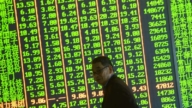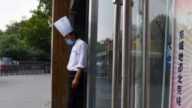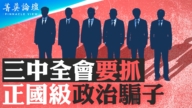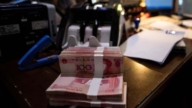【新唐人2014年02月22日讯】中国工厂活动二月份再次收缩,总部设于英国伦敦的“汇丰银行”,周四发布的中国制造业采购经理人指数PMI,加强了外界对中国经济放缓的担忧,并冲击整个中国地区的市场。国际媒体指出,中国的经济放缓加上信贷泡沫,加剧中共的政策困境。
汇丰银行2月20号公布的中国PMI(制造业采购经理人指数),二月份初步调查的数据下跌到七个月以来的最低点–48.3,而一月份的数值,也在代表荣枯指标的界线50之下,只有49.5。PMI指数在50以下,代表经济发展萎缩。
英国《路透社》报导,随着PMI数据出炉,上海证券交易所综合股价指数,2月20号从早盘涨幅回落,亚洲市场则暴跌。
而衡量中国劳工市场的汇丰PMI就业分项指数,已连续第四个月下跌,来到46.9。这是自从2009年2月份以来的最低点。代表中国的就业率也在下降。
《美联社》报导说,汇丰银行的调查显示,过去两年,中国经济发展在无情的放缓。这是工厂活动连续第二个月收缩。一月份PMI下跌到49.5大大出乎外界预料,并搅乱了全球市场好几天,投资者越来越担忧中国巨大制造业的脆弱。
北京天则经济研究所所长助理段绍译:“制造业主要就是今年的总体经济形势不好。另外就是现在中国的劳动力,因为计划生育这么多年的影响,使劳动力的供给减少,劳动力的价格提高,使得很多企业利润降低无利可图,使这方面的出口量减少。”
中国工厂活动在二月份败退,制造业重要指标下滑到七个月来最低,暗示进一步疲软的经济和剑拔弩张的市场。
美国《华尔街日报》引述花旗银行经济学家丁爽的话说﹕中国“经济有持续的下行性压力。”“在未来两个季度,经济增长将继续下滑到7%。” 而日本野村证券经济学家张智威说,中国“第一季度GDP增长将放缓到7.5%,在第二季度将放缓到7.1%。”
北京天则研究所所长助理段绍译认为,除非政府进一步加快改革,把市场潜力激发出来。否则以目前的条件,中国经济肯定将放缓。段绍译强烈倡导“国企私有化”和“土地私有化”,他认为,这将提高生产效率。
段绍译:“我觉得有很多方法可以使中国经济快速增长。比方说,应该把更多国有企业私有化。还有就是土地,农民土地如果能够进一步私有化,这些都是有利于中国经济进一步快速增长的两个重要条件。但是政府并没有这方面想法。”
中国经济放缓的同时,信贷泡沫也很严重。中国的银行借贷和其他信贷在一月份强烈扩张,新增银行贷款达到1万3000亿元,面对双重夹击,中共当局处于决策困境。
《华尔街日报》的报导说,增长在放缓,部分是因为当局担忧金融领域的信贷泡沫,因此推高了借贷的成本。但是政府热切希望不要过于猛烈的踩下借贷的刹车,担忧这样将导致更加低迷的增长和升高的失业率。
一些观察者说,中国应该允许增长放缓,因为它正从依赖信贷投资的经济模式,转向提高消费角色的模式。而政府是否鼓励低增长的一个考验将发生在下个月。中共“两会”召开期间,当局将发布2014年增长目标。
去年年初,随着中国经济增长放缓,政府介入,实施基础设施支出的微刺激方案,提升了经济活动,但是也增加了国家的债务负担。
在中国制造业下滑的同时,制造业巨头“富士康”有淡出大陆,转战它国的迹象。据《美国之音》报导,“富士康”计划在智能手机风靡的印尼首都雅加达投资10亿美元。而在“富士康”与雅加达市达成协议之前,已经在美国宾夕法尼亚州完成了一项研发机器人,花费4000万美元的交易。“富士康”表示,它正在研究美国其它三州,准备进行投资。
采访编辑/秦雪 后制/舒灿
Policy Dilemma over Manufacturing Decline
China’s manufacturing shrank again in February according to the HSBC Purchasing Managers’ Index (PMI) on Thursday. This concern over the Chinese economy slow down and credit bubble have affected the entire Chinese market and exacerbated
a policy dilemma in China.
HSBC reported that China’s February PMI fell to a 7-month low of 48.3 from January’s final reading of 49.5, where a reading below 50 indicates a contraction in the economy.
Reuters report: The Shanghai Composite Index .SSEC gave up its early gains
on the news, while Asian markets tumbled.
Reuters report: The PMI’s employment sub-index fell for a fourth straight
month to 46.9, its lowest point since February 2009, during the global financial crisis.
Reteurs report: February’s PMI reading is the second month in a row that activity has contracted, after a larger-than-expected fall to 49.5 in January roiled global markets for days as investors grew concerned about fragility
in China’s huge manufacturing industry.
Duan Shaoyi, Unirule Institute of Economics, Beijing: The entire factories are mainly in a bad situation this year. Also, the labor sources have been reduced because of the one-child policy. The elevated labor costs have reduced the profit and subsequently the export volume.
Wall Street Journal (WSJ) reported: China’s factory activity lost ground in February, as a key gauge of manufacturing slipped to a seven-month low, signaling further economic weakness and rattling markets.
Economist at Citigroup, Ding Shuang told WSJ: There is continued downward pressure on the economy, and Economic growth will continue to decline to 7% over
the next two quarters.
Economist of Beijing Unirule Institute of Economics, Duan Shaoyi anticipates that the Chinese economy will continue to slow down until the market potential is stimulated by reform. Duan Shaoyi stressed high productivity and efficiency rely on the privatization of state-owned enterprises and land.
Duan Shaoyi: There are many ways to accelerate economic
growth in China. For instance, the privatization of state-owned enterprises and
land would be beneficial to Chinese economic growth.They are the two main factors to speed up growth. However, the government have no such thoughts.
While the Chinese economy slows down, the credit bubble is also getting serious.
China’s bank lending and credit loans in January have expanded strongly in January. The new bank loans have reached 1.3 trillion yuan ($US 214 billion). The Communist regime is faced with a dilemma.
Wall Street Journal (WSJ) reported: Growth is slowing in part because authorities, concerned about credit bubbles in the financial sector, have
pushed up the cost of borrowing. But the government is keen not to apply the brakes on lending too fiercely, fearing this could lead to even lower growth
and rising unemployment.
Some observers say China should allow growth to slow as it transitions away from an economy dependent on credit-fueled investment to one in which higher levels of consumption play a greater role. A test of whether the government can countenance lower growth will come next month, when authorities unveil a growth target for 2014 at the opening of the once-a-year meeting of China’s
largely ceremonial parliament.
WSJ: As growth slowed early in 2013, due in part to tighter lending conditions, the government stepped in with a mini-stimulus package of infrastructure spending that lifted economic activity but added to the nation’s debt burden.
While China’s manufacturing decline, Foxconn is seeking alternative clientele outside of China. Voice of America reported, Foxconn’s latest ambition calls
for investing $1 billion in Jakarta, Indonesia. Voice of America: Foxconn’s agreement with the city of Jakarta follows a deal in November to spend $40 million on robotics…in the U.S. state of Pennsylvania.
Foxconn was also studying three other U.S. states for investment
Interview & Edit/Qinxue Post-Production/Shucan



























